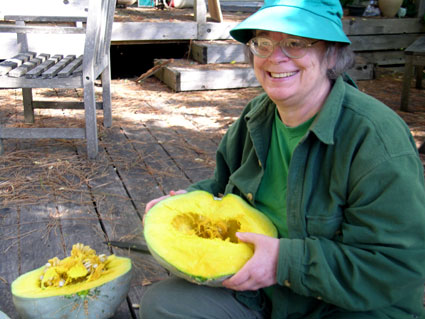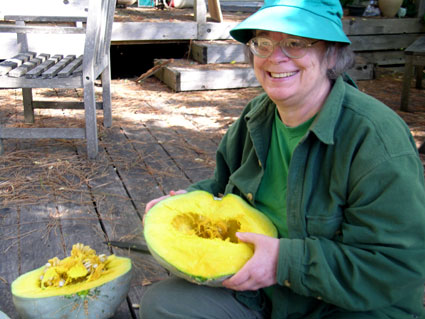 As weather patterns change and fossil fuel supplies dwindle, communities have to start thinking about food resilience. How can farmers and gardeners grow and preserve food amid rapidly changing weather conditions, and without easy access to cheap industrial fertilizers? In her new book, The Resilient Gardener: Food Production and Self-Reliance in Uncertain Times, longtime gardener and scientist Carol Deppe digs into just such questions.
As weather patterns change and fossil fuel supplies dwindle, communities have to start thinking about food resilience. How can farmers and gardeners grow and preserve food amid rapidly changing weather conditions, and without easy access to cheap industrial fertilizers? In her new book, The Resilient Gardener: Food Production and Self-Reliance in Uncertain Times, longtime gardener and scientist Carol Deppe digs into just such questions.
I recently talked to Deppe about how her form of resilient gardening compares to “traditional” gardening, the importance of not seeking perfection, and how all of this ties into food security.
Q. What’s the first step toward achieving food resilience?
A. There are three ways to do that. The first is through local buying patterns and trade. A second is through knowing how to store or process food that is available locally, whether we grow it ourselves or not. The third is gardening. In The Resilient Gardener, I talk as much about storing and using food as growing it. I love gardening, but not everyone is in a position to garden every year of their lives. However, the person who has learned to make spectacular applesauce or cider or apple butter or pies can often trade some of the processed products for all the apples needed.
Gardening is important, but so is trade. Neanderthal stone tools, interestingly, are all found within a few miles of where the rocks originated. And the tools didn’t change very much over time. But Homo sapiens that lived at the same time had tools made from rocks that were clearly traded over long distances. And Homo sapiens’ tools changed and developed rapidly. We traded our ideas along with stuff. Any Neanderthal tribe that met a sapiens tribe was a single tribe against an entire species. I’m a Homo sapiens, and I follow Homo sapien traditions. I aim for appropriate self-reliance, not for independence. Independence is for Neanderthals.
 Gourdian angel: Gardener amd scientist Carol Deppe Photo: Keane McGee, Nichols Garden Nursery
Gourdian angel: Gardener amd scientist Carol Deppe Photo: Keane McGee, Nichols Garden Nursery
Q. Traditional gardening books show perfectly tended ornamental beds and flawless vegetables that look almost too good to eat. How is “resilient” gardening different?
A. Much of our garden writing is about the gardens of rich people who have employees to do the work. Even non-rich people with full-time jobs and no hired help are encouraged to take the gardens of rich people as their model. Beauty and showing off and ornamental plantings and huge high-maintenance inedible lawns have mattered more than food, for example. I’m not rich enough and haven’t the time or inclination for that sort of gardening. I delight in all the knowledge about plants, ecology, and gardening we have today. But I take peasants as my basic model. I aim to be a modern peasant. I focus primarily upon growing food, especially upon staple crops and crops of special nutritional value. And I want lots of delicious food for the least possible work.
In addition, in the real world, things are always going wrong. These can be private or personal, such as an injury or family emergency that removes your labor from the garden for a while. Or they can be financial. Loss of a job can mean you really need to know how to get most of your food from the garden, not just fruits and vegetables.
The resilient gardener knows we have our ups and downs, as individuals, families, societies, and as a species. The resilient garden is designed and managed so that when things go wrong, they have less impact. Most gardens are good-time gardens. They self-destruct rapidly if deprived of our labor. They depend upon constant imports of fertilizer and seeds. They need relatively stable weather. The resilient gardener has learned to operate with minimal external inputs, and in a world where climate is changing and weather is more erratic. The resilient gardener knows how to save seeds. The resilient garden is one that thrives and helps its people and their communities survive and thrive through everything that comes their way, from tomorrow through the next thousand years.
Q. The huge topic of global climate change can seem daunting when you’re considering cultivating a small patch of land near where you live. What do gardeners need to know about climate change?
A. For the last 50 years, the weather patterns have generally been unusually stable. Our modern gardening and agricultural practices actually depend upon that stability. Our farms and gardens have become good-time farms and gardens. They are likely to fail just when we need them most. We now need gardens and farms that survive and thrive in the face of greater unpredictability.
Wild erratic weather is typical of climate change, and is much more important to gardeners and farmers than a fraction of a degree’s change in average global climate. However, humanity has made it through the transition from relative stability to instability in climate before, for example, in our adjustment to the erratic weather of the Little Ice Age. There are agricultural patterns and methods we have developed in the past when we needed them that we can relearn and expand upon today.
Q. In your book, you focus on five crops for achieving resilience: potatoes, corn, beans, squash, and eggs. Talk about one of them. Why potatoes?
A. Potatoes are a great source of both carbohydrates and protein. They yield more carbohydrate per square foot than anything we can grow in temperate climates. They yield more protein per square foot than anything we can grow except beans. They have good levels of vitamin C and significant amounts of calcium and other minerals. They are the easiest of all staple crops to grow. They yield much more carbohydrate and protein than anything else per unit labor. Small grains take fine seed beds, meaning tillers, tractors, or draft animals. Anyone with a shovel can grow potatoes. And potatoes can be grown on rough land, land just converted from lawn or pasture or patch of weeds. Grains usually require special grinding equipment. Anyone who can build a fire can cook potatoes. Potatoes grow well in places too cold or wet for grains. Potatoes are far more impervious to nasty weather than grains.
People these days tend to remember the Irish Potato Famine, when late blight destroyed the entire Irish potato crop. But we should also remember that the potato was one of the major saviors of Europeans during the Little Ice Age — a crop that was central to their adjustment to the erratic weather associated with climate change, a crop that yielded year in year out, decade in decade out, before there were any problems.



